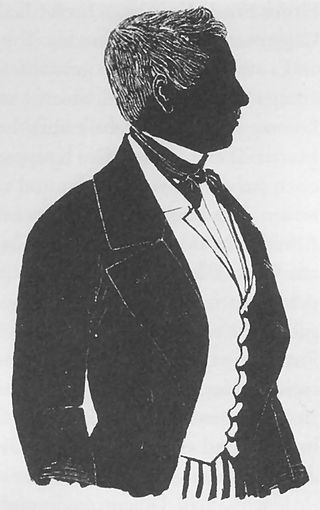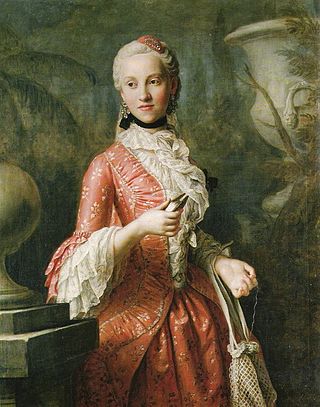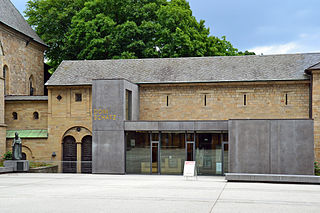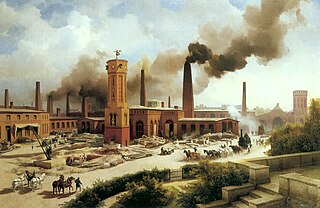
Krupp, also known as Friedrich Krupp AG and later Friedrich Krupp AG Hoesch-Krupp after acquiring Hoesch AG in 1991, was the largest company in Europe at the beginning of the 20th century as well as Germany's premier weapons manufacturer during both world wars. From the Thirty Years' War to the end of World War II, it produced battleships, U-boats, tanks, howitzers, guns, utilities, and hundreds of other commodities. The company also produced steel used to build railroads in the United States and to cap the Chrysler Building.

The Ruhr, also referred to as the Ruhr area, sometimes Ruhr district, Ruhr region, or Ruhr valley, is a polycentric urban area in North Rhine-Westphalia, Germany. With a population density of 2,800/km2 and a population of over 5 million (2017), it is the largest urban area in Germany. It consists of several large cities bordered by the rivers Ruhr to the south, Rhine to the west, and Lippe to the north. In the southwest it borders the Bergisches Land. It is considered part of the larger Rhine-Ruhr metropolitan region of more than 10 million people, which is the third largest in Western Europe, behind only London and Paris.

Essen is the central and, after Dortmund, second-largest city of the Ruhr, the largest urban area in Germany. Its population of 584,580 makes it the fourth-largest city of North Rhine-Westphalia after Cologne, Düsseldorf and Dortmund, as well as the ninth-largest city of Germany. Essen lies in the larger Rhine-Ruhr metropolitan region, second largest by GDP in the EU, and is part of the cultural area of Rhineland. Because of its central location in the Ruhr, Essen is often regarded as the Ruhr's "secret capital". Two rivers flow through the city: the Emscher in the north, and in the south the Ruhr River, which is dammed in Essen to form the Lake Baldeney (Baldeneysee) and Lake Kettwig reservoirs. The central and northern boroughs of Essen historically belong to the Low German (Westphalian) language area, and the south of the city to the Low Franconian Bergish area.

Bochum is a city in North Rhine-Westphalia. With a population of 372,348, it is the sixth largest city in one of the most populous German federal states of North Rhine-Westphalia, and the 16th largest city of Germany. On the Ruhr Heights (Ruhrhöhen) hill chain, between the rivers Ruhr to the south and Emscher to the north, it is the second largest city of Westphalia after Dortmund, and the fourth largest city of the Ruhr after Dortmund, Essen and Duisburg. It lies at the centre of the Ruhr, Germany's largest urban area, in the Rhine-Ruhr Metropolitan Region, and belongs to the region of Arnsberg. Bochum is the sixth largest and one of the southernmost cities in the Low German dialect area. There are nine institutions of higher education in the city, most notably the Ruhr University Bochum, one of the ten largest universities in Germany, and the Bochum University of Applied Sciences.

ThyssenKrupp AG is a German industrial engineering and steel production multinational conglomerate. It resulted from the 1999 merger of Thyssen AG and Krupp and has its operational headquarters in Duisburg and Essen. The company claims to be one of the world's largest steel producers, and it was ranked tenth-largest worldwide by revenue in 2015. It is divided into 670 subsidiaries worldwide. The largest shareholders are the Alfried Krupp von Bohlen und Halbach Foundation and Cevian Capital. ThyssenKrupp's products range from machines and industrial services to high-speed trains, elevators, and shipbuilding. The subsidiary ThyssenKrupp Marine Systems also manufactures frigates, corvettes, and submarines for the German and foreign navies.

The University of Duisburg-Essen is a public research university in North Rhine-Westphalia, Germany. In the 2019 Times Higher Education World University Rankings, the university was awarded 194th place in the world. It was originally founded in 1654 and re-established on 1 January 2003, as a merger of the Gerhard Mercator University of Duisburg and the university of Essen. It is based in both the cities of Duisburg and Essen, and a part of University Alliance Metropolis Ruhr.

Friedrich Carl Krupp was a German steel manufacturer and founder of the Krupp family commercial empire that is now subsumed into ThyssenKrupp AG.

Essen Minster, since 1958 also Essen Cathedral is the seat of the Roman Catholic Bishop of Essen, the "Diocese of the Ruhr", founded in 1958. The church, dedicated to Saints Cosmas and Damian and the Blessed Virgin Mary, stands on the Burgplatz in the centre of the city of Essen, Germany.

The Industrial Heritage Trail links tourist attractions related to the industrial heritage in the Ruhr area in Germany. It is a part of the European Route of Industrial Heritage. The series of routes were developed between 1989 and 1999, however additions are still being made.

Hoesch was a German steel and mining conglomerate headquartered in Dortmund and several subsidiaries across the Ruhr region and Siegen. Founded in 1871, by Leopold Hoesch, it employed over 30,000 people by 1938 and was among the largest companies in Nazi Germany.

The actual boundaries of the Ruhr vary slightly depending on the source, but a good working definition is to define the Lippe and Ruhr as its northern and southern boundaries respectively, the Rhine as its western boundary, and the town of Hamm as the eastern limit.

Essen West station is situated in Essen on the Witten/Dortmund–Oberhausen/Duisburg railway in the German state of North Rhine-Westphalia. It is served by lines S1, S3 and S9 of the Rhine-Ruhr S-Bahn.

Maria Kunigunde of Saxony was Princess-Abbess of Essen and Thorn. She was a titular Princess of Poland, Lithuania and Saxony of the Albertine branch of the House of Wettin. She was a member of the Order of the Starry Cross and a collegiate lady in the abbey at Münsterbilzen.
The following is a timeline of the history of the city of Essen, Germany.

The Essen Cathedral Treasury is one of the most significant collections of religious artworks in Germany. A great number of items of treasure are accessible to the public in the treasury chamber of Essen Minster. The cathedral chapter manages the treasury chamber, not as a museum as in some places, but as the place in which liturgical implements and objects are kept, which continued to be used to this day in the service of God, so far as their conservation requirements allow.

Industrialization in Germany was the phase of the breakthrough of industrialization in Germany, beginning at the time from around 1815 to 1835. This period was preceded by the periods of pre-industrialization and early industrialization. In general, the decades between the 1830s and 1873 are considered the phase of industrial take off. The Industrial Revolution was followed by the phase of high industrialization during the German Empire. The (catch-up) Industrial Revolution in Germany differed from that of the pioneering country of Great Britain in that the key industries became not the textile industry but coal production, steel production and railroad construction.

Richard Rudolf Walter Siepmann known as Walter Siepmann, Sr. was a German industrialist, engineer and inventor. He was the youngest son of Hugo Siepmann and prominent member of the Siepmann family. He was the majority owner of Siepmann Group, an industrial concern, as well as a board member of Commerzbank and board director of the Mechanical Engineering Industry Association (VDMA). Since 1940 he served as a councilor of Belecke (Warstein) for the Christian Democratic Union (CDU).

The Krupp steelworks, or Krupp foundry, or Krupp cast steel factory in Essen is a historic industrial site of the Ruhr area of North Rhine-Westphalia in western Germany that was known as the "weapons forge of the German Reich".
Carl Louis Alfred Traugott Lämmerhirt was a German industrialist, engineer and founding member of Westfalia Dinnendahl Gröppel, initially based in Bochum. He was the father-in-law of Hugo Siepmann and Robert Fricke.

The Krupp family is a prominent 400-year-old German dynasty from Essen, noted for its production of steel, artillery, ammunition and other armaments.




















